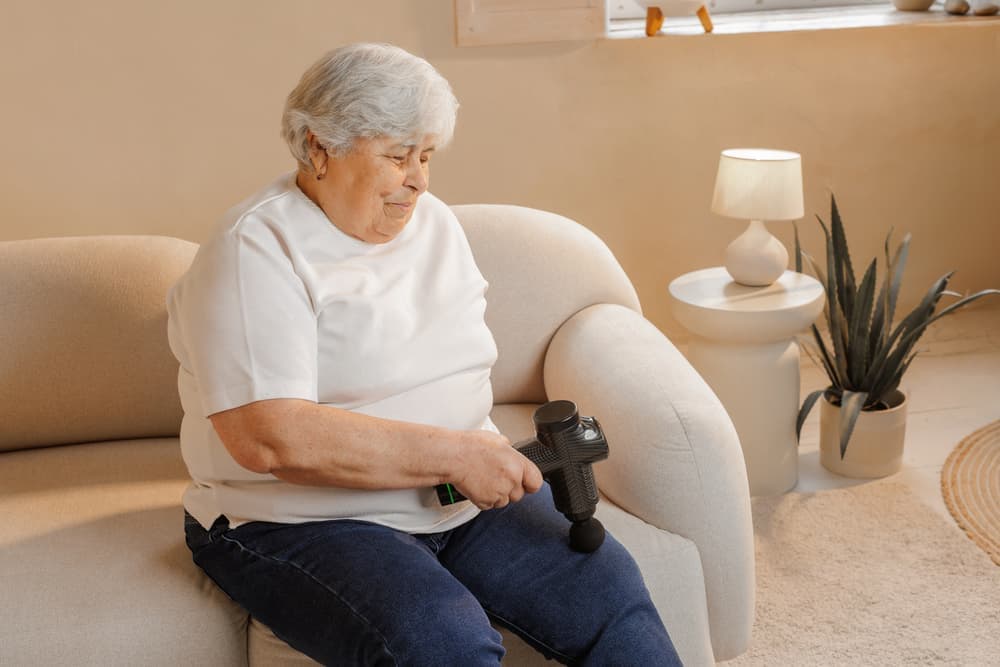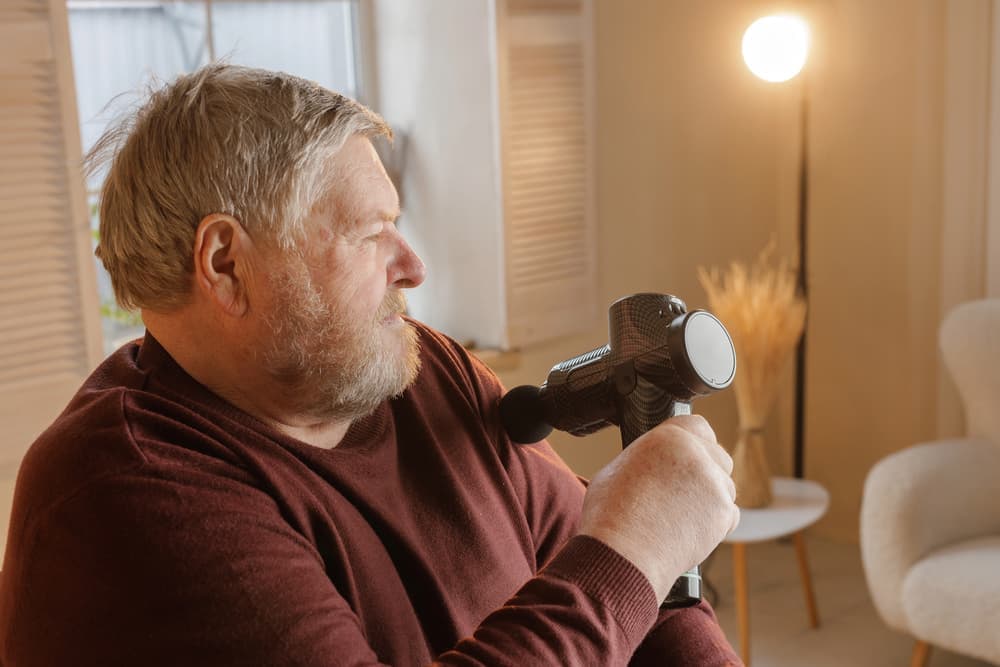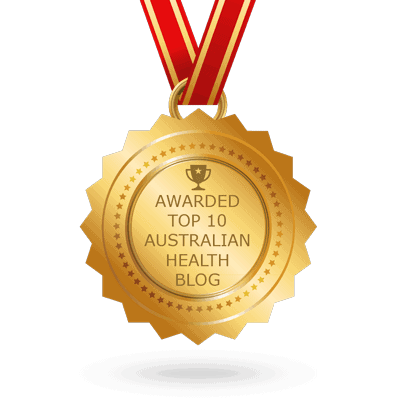Seniors should exercise caution when using a massage gun.
Before using one, it’s best to consult a doctor or physical therapist, especially if you have conditions like arthritis or osteoporosis. It also is advisable to start with low intensity and avoid sensitive areas such as the neck and joints.
Then, always follow the manufacturer’s instructions, and discontinue use of the massage gun if you experience pain or skin irritation.
Massage guns have become a go-to tool for pain relief and muscle recovery, and it’s no surprise that older adults are curious about giving them a go. They’re simple, non-invasive, and can bring real comfort. However, they’re not risk-free.
Keep reading to learn why understanding these risks can help you stay safe and comfortable.
Why Seniors Are Turning to Massage Guns
Seniors are turning to massage guns for many good reasons.
These handy devices help ease muscle tension, improve blood flow, and reduce stiffness, making it easier to move and stay active. Using a massage gun at home is easy and convenient, providing self-care that accommodates most lifestyles.
Research shows that massage guns can help with flexibility, range of motion, and faster muscle recovery. Although specific data is scarce, a 2022 study concludes it might help older adults with muscle pain if used cautiously.
Here’s what you should know to make the most of your massage gun sessions.

Key Precautions Seniors Should Take Before Massage Gun Use
Using a massage gun can be helpful, but taking a few safety steps is also important. These help protect your health and make sure the tool works well for you.
1. Consult a Physician or Physical Therapist
Before trying a massage gun, talk to your doctor or physio, especially if you have:
- Arthritis
- Osteoporosis
- Circulatory problems (e.g. you are taking blood-thinning medication or have poor blood flow or leg ulcers)
Custom advice helps guarantee the safe use of the tool. For example, leg ulcers affect approximately 1% of Australians and often involve poor blood circulation. Massaging these areas could cause harm.
2. Start with the Lowest Intensity
Your muscles and skin can be sensitive. To be safe:
- Always begin on the lowest speed setting.
- Only increase intensity if you’re comfortable.
- Avoid pushing too hard as this can bruise or irritate your skin.
3. Avoid Sensitive or High-Risk Areas
Don’t use the massage gun on your:
- neck or spine
- joints or bony spots
- face or areas with thin skin
- bruised, wounded, or inflamed spots
Remember that older skin is thinner and more likely to be injured, especially over bony areas. Check out this article for more body areas to avoid when using your massage gun.
4. Focus on Large Muscle Groups
The safest and most helpful areas for massage gun therapy include:
- thighs and hamstrings
- calves
- shoulders
- upper arms
These muscle areas respond well to gentle massage and can help improve your flexibility and reduce tightness.

Best Practices for Safe Massage Gun Use
Follow these simple good habits to get the benefits of every massage gun session while avoiding unwanted risks.
1. Follow the Manufacturer’s Guidelines
Every massage gun is a little different, so don’t skip the manual. It will tell you:
- How long each session should last: Target 30 seconds to 2 minutes per muscle group, up to 10-15 minutes total.
- How often to use it: Limit use to once or twice a day to prevent overuse or irritation.
- Which muscle groups to target: Focus only on areas suited for massage gun therapy.
- Which attachment heads to use for each area: Follow the guide to avoid accidental harm.
Do not make DIY changes or use the wrong massage gun attachment to avoid damaging the device or hurting yourself.
2. Monitor for Adverse Reactions
Your body will give you clear signals if something isn’t right. Be sure to stop use immediately if you notice:
- Pain
- Redness or swelling
- Skin irritation
- Bruising
Older adults are often more prone to bruising when using a massage gun because of their thinner skin. If symptoms keep coming back, it’s best to check with a healthcare provider.
3. Create a Relaxing Environment
In percussive therapy, setting matters just as much as technique. To make the most of your session, try to:
- Use the massage gun in a calm, well-lit space.
- Sit or lie down comfortably to avoid straining or slipping.
- Pair your session with slow breathing or calming music for extra relaxation.
By combining these safe practices, you can enjoy the soothing benefits of your massage gun with confidence.

Alternatives to Massage Guns for Seniors
Massage guns aren’t the only option for seniors to ease sore muscles or improve flexibility.
If you’d prefer gentler or more traditional approaches, some alternatives can be just as effective, sometimes even safer for older bodies.
Here are a few examples:
- Foam rollers or massage balls. These provide light, controlled pressure and can help release muscle tension. They’re also budget-friendly and easy to use at home.
- Traditional massage therapy. Working with a certified practitioner gives you a personalised approach.
- Mobility or stretching exercises. Gentle routines designed for seniors support joint health and keep you moving comfortably.
- Heat therapy or low-impact movement. A warm compress, gentle yoga, or even a short walk can ease stiffness and improve blood flow without the intensity of a massage gun.
Exploring these alternatives ensures you can find a self-care method that feels safe, effective, and enjoyable.
Stay Safe with Smart Massage Gun Use
With the right precautions, massage guns can be a helpful part of your wellness journey.
Remember to prioritise safety by consulting your doctor, starting with low settings, and avoiding sensitive areas. Listen to your body and stop if you feel pain or discomfort. Then, when in doubt, talk to a healthcare professional or explore other safe ways to ease muscle tension and improve flexibility.
For trusted options, check our list and reviews of the best massage guns in Australia.
Related Questions
1. Are massage guns safe for seniors with arthritis?
Massage guns may be safe for some seniors with arthritis, but always consult a doctor first. If the doctor approves, be sure to focus on massaging the muscles around, rather than on, the affected joint. Improper use could worsen inflammation or pain.
2. What should seniors do if they feel pain after using a massage gun?
Stop using the massage gun right away if you feel pain. Apply a cold compress if there’s swelling, and see a doctor if the pain continues. Seniors should get medical clearance before resuming use, especially if taking blood thinners or managing conditions like arthritis.
- Can Short Workouts Really Boost Daily Energy? - 28 October 2025
- How Can You Build a Balanced Plate for Every Meal? - 27 October 2025
- What Is a Yoga Wheel and How to Use It? - 29 September 2025
